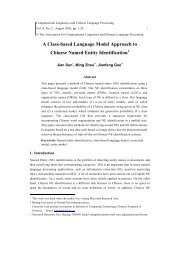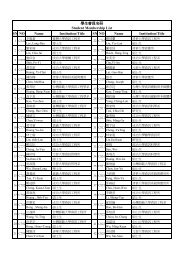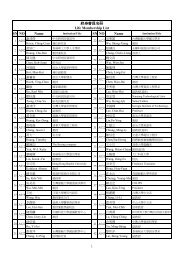Machine Translation Approaches and Survey for Indian ... - aclclp
Machine Translation Approaches and Survey for Indian ... - aclclp
Machine Translation Approaches and Survey for Indian ... - aclclp
Create successful ePaper yourself
Turn your PDF publications into a flip-book with our unique Google optimized e-Paper software.
<strong>Machine</strong> <strong>Translation</strong> <strong>Approaches</strong> <strong>and</strong> <strong>Survey</strong> <strong>for</strong> <strong>Indian</strong> Languages 674.31 Rule-based Reordering <strong>and</strong> Morphological Processing ForEnglish-Malayalam SMT (2009)This is an attempt to develop a statistical-based MT <strong>for</strong> English to Malayalam language by aset of MTech students under the guidance of Dr. K P Soman (Rahul et al., 2009). In thisapproach, they showed that a SMT based system can be improved by incorporating therule-based reordering <strong>and</strong> morphological in<strong>for</strong>mation of source <strong>and</strong> target languages.4.32 SMT using Joshua (2011)A piloted SMT based English to Telugu MT (MT) System called “enTel” was developed byAnitha Nalluri <strong>and</strong> Vijayan<strong>and</strong> Kommaluri, based on Johns Hopkins University Open SourceArchitecture (JOSHUA) (Anitha et al., 2011). A Telugu parallel corpus from the EnablingMinority Language Engineering (EMILLE) developed by CIIL Mysore <strong>and</strong> English to TeluguDictionary, developed by Charles Philip Brown, is considered <strong>for</strong> training the translationsystem.4.33 Multilingual Book ReaderThe NLP team, including Prashanth Balajapally, Phanindra B<strong>and</strong>aru, Ganapathiraju, N.Balakrishnan <strong>and</strong> Raj Reddy, introduced a multilingual book reader interface <strong>for</strong> DLI thatsupports transliteration <strong>and</strong> good enough translation (Prashanth) based on transliteration, wordto word translation <strong>and</strong> full-text translation <strong>for</strong> <strong>Indian</strong> language. This is a simple, inexpensivetool that exploits the similarity between <strong>Indian</strong> languages. This tool can be useful <strong>for</strong>beginners who can underst<strong>and</strong> their mother tongue or other <strong>Indian</strong> languages, but cannot readthe script, <strong>and</strong> <strong>for</strong> an average reader who has the domain expertise. This tool can be also beused <strong>for</strong> translating either the documents or the queries in a multilingual search purpose.4.34 A Hybrid Approach to EBMT <strong>for</strong> English to <strong>Indian</strong> Languages (2007)Vamshi Ambati <strong>and</strong> U Rohini proposed a hybrid approach to EBMT (EBMT) <strong>for</strong> English to<strong>Indian</strong> languages that makes use of SMT methods <strong>and</strong> minimal linguistic resources (Ambati etal., 2007). Currently work is going on to develop English to Hindi as well as other <strong>Indian</strong>language translation systems based on manual <strong>and</strong> a statistical dictionary built from an SMTtool using an example database consisting of source <strong>and</strong> target parallel sentences.4.35 SMT by Incorporating Syntactic <strong>and</strong> Morphological ProcessingAnanthakrishnan Ramanathan, Pushpak Bhattacharyya, Jayprasad Hegde, Ritesh M. Shah, <strong>and</strong>M. Sasikumar proposed a new idea to improve the per<strong>for</strong>mance of the SMT based MT byincorporating syntactic <strong>and</strong> morphological processing (Ananthakrishnan). In this contest, theyproved that per<strong>for</strong>mance of a baseline phrase-based system can be substantially improved by i)









